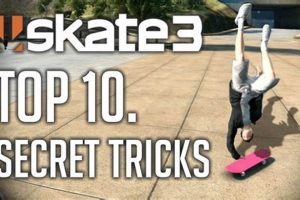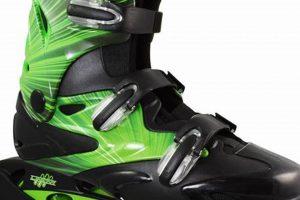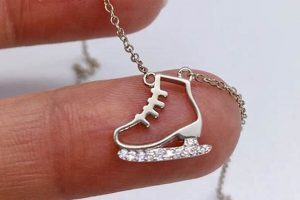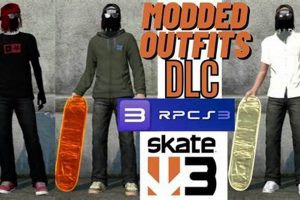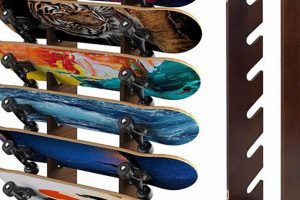A specialized configuration of wheeled footwear, characterized by an upward curvature on the front and rear wheels, facilitates enhanced maneuverability and turning capabilities. This design allows for a pivot point near the center of the skate, reducing the contact area with the ground and enabling tighter turns and swifter directional changes. An example of this technology finds application in artistic skating and certain forms of roller derby.
The adoption of this design offers considerable advantages in contexts demanding agility and rapid responsiveness. Its ability to execute sharp turns contributes to improved performance and control. Historically, this configuration has been adopted to mimic the feel of ice skating on surfaces that are not ice, and its enduring presence across varied skating disciplines suggests its value and sustained relevance within the sport.
Understanding the specifics of this design is essential before delving into topics such as optimal wheel placement, frame construction material choices, and the effect of specific bearing types on performance and durability. Subsequent discussion will explore these areas in greater detail to provide a more complete understanding of how these components impact the user’s experience.
Rocker Skate
The following guidelines detail strategies for maximizing the benefits of a rocker skate setup, focusing on control, agility, and adaptation to varied skating styles.
Tip 1: Wheel Hardness Selection. Employing softer wheels enhances grip, beneficial for indoor surfaces and maneuvers requiring precise control. Conversely, harder wheels prioritize speed on smoother, outdoor surfaces.
Tip 2: Frame Length Considerations. Shorter frames increase maneuverability, ideal for artistic skating and quick turns. Longer frames promote stability at higher speeds, advantageous for speed skating and distance applications.
Tip 3: Rocker Height Adjustment. The degree of curvature affects agility. Smaller rocker amounts provide subtle turning assistance, while larger amounts enable sharper, more immediate pivots. Careful calibration based on skill level and intended use is recommended.
Tip 4: Bearing Maintenance Protocols. Regularly cleaning and lubricating bearings ensures smooth wheel rotation and maximizes speed. Debris accumulation impedes performance and reduces bearing lifespan. Consistent maintenance intervals are crucial.
Tip 5: Boot Stiffness Matching. The boot’s rigidity should complement the intended use. Stiffer boots offer improved support and power transfer, while more flexible boots allow for greater freedom of movement and comfort during longer sessions.
Tip 6: Surface Condition Awareness. Adjust skating technique based on surface conditions. Smooth surfaces demand different control strategies compared to rough or uneven terrains. Adapting to environmental variables enhances safety and control.
Tip 7: Regular Skill Assessment. Continuously evaluate skating proficiency and adjust equipment setup accordingly. As skill levels increase, further adjustments to wheel configuration and frame setup may be necessary to maintain optimal performance.
Adhering to these guidelines supports enhanced performance, increased control, and overall improved skating experience. Implementing these optimized settings is key to maximizing the full potential.
Consider these insights before examining more complex modifications and advanced techniques within the realm of specialized skating equipment.
1. Enhanced Maneuverability
The connection between the rocker skate configuration and enhanced maneuverability is direct and fundamental. The upward curvature of the front and rear wheels reduces the contact area between the wheels and the skating surface. This reduction in contact allows the skate to pivot more freely around its center point, facilitating quicker and more precise turns. This enhanced maneuverability is not merely an abstract concept; it directly translates to improved performance in disciplines requiring agility and responsiveness.
Artistic roller skating provides a concrete example of this relationship. The execution of intricate spins, leaps, and footwork patterns depends critically on the skater’s ability to rapidly change direction and maintain balance. Without the enhanced maneuverability afforded by the rocker configuration, these complex routines would be significantly more difficult, if not impossible, to perform. Similarly, in roller derby, the ability to quickly navigate the pack and avoid obstacles is paramount, and the rocker skate’s maneuverability provides a distinct competitive advantage. Beyond competitive arenas, this design also allows the skater to respond quickly to unexpected hazards during recreational skating, improving overall safety.
The practical significance of understanding this connection lies in optimizing skate setup and technique. Recognizing how the degree of rocker affects maneuverability allows skaters to fine-tune their equipment to match their specific needs and skating style. Understanding the limitations, challenges such as reduced stability at high speeds, associated with reduced contact points also promotes safer and more effective skating. This knowledge contributes to an increased awareness of the rocker skate’s function, enhancing performance and minimizing risk.
2. Tighter Turning Radius
The defining characteristic of a rocker skate resides in its capacity to achieve a significantly reduced turning radius compared to conventional inline or quad skates. This capability stems directly from the wheel arrangement. Unlike skates where all wheels maintain consistent ground contact, the rocker configuration features a curvature where the central wheels protrude slightly, while the front and rear wheels are elevated. This strategically limited contact point allows the skater to pivot around a smaller area, thereby enabling sharper, more immediate turns. The importance of this design element is paramount in disciplines demanding quick directional changes, such as artistic skating or roller derby, where the ability to navigate confined spaces and execute rapid maneuvers is crucial.
The practical application of this tighter turning radius translates directly into enhanced performance in various scenarios. In artistic skating, for example, intricate spins and complex footwork sequences become more fluid and attainable. The skater can initiate and complete turns with greater precision and speed, contributing to a more dynamic and visually appealing performance. Similarly, in roller derby, the ability to quickly change direction allows players to evade opponents, navigate crowded tracks, and maintain strategic positioning. The effectiveness of offensive and defensive maneuvers is significantly enhanced by the responsiveness afforded by the rocker design. The tighter turning radius also proves beneficial in recreational skating, allowing skaters to navigate crowded areas and avoid obstacles more easily.
In summary, the tight turning radius enabled by the rocker configuration is not merely a performance enhancement; it constitutes a fundamental design element that defines its functionality and purpose. The ability to execute sharper, more immediate turns translates directly into improved agility, responsiveness, and control across various skating disciplines. Understanding this connection empowers skaters to optimize their equipment setup and refine their technique, leading to enhanced performance and increased safety.
3. Artistic Skating Application
The artistic skating discipline relies heavily on specialized equipment configurations to facilitate the execution of complex routines. The connection between artistic skating and the rocker skate design is particularly significant, as the curvature of the wheels directly enables the precise movements and maneuvers that characterize this sport.
- Enhanced Edge Control
The rocker configuration permits skaters to engage the edges of their skates more effectively, providing greater control during turns, spins, and intricate footwork sequences. This enhanced edge control allows for deeper leans and more pronounced angles, contributing to the fluidity and precision required in artistic skating. Without this, skaters are more likely to slip and they cannot execute the moves well.
- Improved Spin Performance
The reduced contact area inherent in a rocker skate promotes faster and more controlled spins. The central wheels act as a pivot point, allowing skaters to initiate and maintain spins with greater ease. This improvement is critical in artistic skating, where spin variations constitute a significant portion of the routine.
- Greater Agility in Footwork
The agility afforded by the rocker configuration allows for rapid transitions between edges and directions, essential for executing complex footwork patterns. Skaters can quickly change their weight distribution and shift their body position, enabling them to perform intricate steps and turns with speed and precision. The difference is obvious.
- Creative Expression Amplification
Ultimately, the enhanced control, spin performance, and agility provided by the rocker skate design empower artistic skaters to express themselves more fully through their routines. The equipment becomes an extension of the skater’s body, allowing them to push the boundaries of creativity and athleticism. The artistic skaters are known for this.
In summary, the rocker skate is an indispensable tool for artistic skaters, providing the necessary performance attributes to execute complex routines and express themselves creatively on the rink. The design’s influence extends beyond mere equipment functionality, shaping the very nature and aesthetic of artistic skating.
4. Agility Focused Design
Agility, defined as the capacity for rapid and controlled directional changes, forms the cornerstone of the rocker skate’s underlying design philosophy. This configuration, characterized by a pronounced curvature of the wheel set, prioritizes maneuverability over raw speed, differentiating it from other skating setups optimized for linear motion. The limited ground contact inherent in the rocker profile reduces friction, enabling quicker pivots and tighter turns. This inherent agility is not accidental; it is the direct result of deliberate engineering choices aimed at maximizing responsiveness and control. As a result, the “rocker skate” is synonymous with an agility-focused design.
The practical implications of this design are evident across various skating disciplines. In artistic skating, the ability to execute intricate footwork patterns and rapid transitions is paramount; the rocker skate empowers skaters to navigate complex routines with precision and grace. Roller derby participants benefit from the increased maneuverability, enabling them to evade blockers and maintain strategic positioning within the pack. Even in recreational skating, the agility afforded by this design enhances safety by allowing skaters to react quickly to unexpected obstacles or changes in terrain. In each of these contexts, the enhanced agility provided by the rocker skate directly translates into improved performance and control.
In summary, the agility-focused design is not merely a feature of the rocker skate; it is its defining characteristic. The deliberate manipulation of wheel contact points results in a configuration optimized for maneuverability and responsiveness, enabling skaters to excel in disciplines demanding rapid directional changes. While this design choice may compromise top-end speed and stability, the resulting agility offers significant advantages in specific contexts, underscoring the importance of understanding the trade-offs inherent in different skating equipment configurations. Future refinements of rocker skate design may explore innovative approaches to mitigate the limitations while further enhancing its inherent agility.
5. Pivoting Proficiency
Pivoting proficiency, the skill of rotating around a fixed point with speed and control, is intrinsically linked to the functional advantages offered by rocker skates. The specific design characteristics of rocker skates significantly enhance a skater’s ability to execute pivots, impacting overall performance and maneuverability. The analysis below delineates the core elements contributing to this enhanced proficiency.
- Reduced Contact Area
Rocker skates, distinguished by their curved wheel configuration, minimize contact with the skating surface. This diminished contact area allows for smoother and more rapid rotations, as less friction impedes movement. The reduction in friction translates directly to easier pivot initiation and execution. Real-world examples are evident in artistic skating, where controlled spins are essential, or roller derby, where quick turns are crucial for evasion and positioning.
- Centralized Weight Distribution
The rocker design encourages a more centralized weight distribution over the central wheels. This centralization facilitates pivoting by creating a stable axis around which the skater can rotate. This weight distribution becomes particularly important during complex maneuvers, such as performing a 180-degree turn or executing intricate footwork patterns. This allows more agile movements, enhancing a skater’s ability to quickly change direction and adapt to dynamic conditions.
- Enhanced Edge Control
While the reduced contact area promotes easier pivoting, the ability to engage the edges of the wheels remains crucial for maintaining control during rotations. Rocker skates facilitate enhanced edge control, allowing skaters to modulate the degree of pivot with precision. The skater can subtly adjust their lean angle and pressure on the wheels to refine the speed and direction of the pivot. This nuanced control is invaluable in artistic skating, where minute adjustments can significantly impact the aesthetic and technical execution of a routine.
- Improved Responsiveness
The combination of reduced contact area, centralized weight distribution, and enhanced edge control contributes to an overall improvement in the skater’s responsiveness. Rocker skates allow for quicker reactions and more immediate responses to changes in momentum and balance. This responsiveness is particularly beneficial in high-speed scenarios or situations requiring rapid adjustments, such as avoiding collisions or navigating crowded skating environments. Improved control over rotations reduces the likelihood of losing balance and enhances overall skating efficiency.
These interconnected facets underscore how the design of rocker skates directly fosters improved pivoting proficiency. By minimizing friction, stabilizing the center of gravity, enabling refined edge control, and ultimately enhancing responsiveness, these skates equip skaters with the necessary tools to execute pivots with greater speed, precision, and control. The benefits are observable in a multitude of skating disciplines, highlighting the significant impact of the rocker configuration on overall performance.
6. Curved Wheel Profile
The curved wheel profile is the defining structural element of a rocker skate. It is not merely a feature, but rather the fundamental design characteristic that dictates the skate’s performance and functionality. The curvature, typically achieved through a specific arrangement of wheel sizes or by deliberately offsetting the wheel axles, creates a reduced contact area between the wheels and the skating surface. This reduction in contact is the direct cause of the enhanced maneuverability and tighter turning radius associated with rocker skates. Without the curved wheel profile, the skate would cease to function as intended, reverting to the characteristics of a conventional inline or quad skate.
A practical example of the curved wheel profile’s significance is found in artistic skating. The complex spins and intricate footwork routines depend on the skater’s ability to quickly change direction and maintain balance. The curved wheel profile allows for sharper turns and more fluid transitions, enabling the skater to execute these maneuvers with greater precision and control. Similarly, in roller derby, the agility afforded by the curved wheel profile is crucial for navigating crowded tracks and evading opponents. By reducing the wheel-to-surface contact, the curved wheel profile also reduces friction, enhancing the skate’s responsiveness to subtle shifts in weight and body position. The profile configuration is optimized based on these parameters.
In summary, the curved wheel profile is not merely a design element; it is the essential component that defines the function and performance of a rocker skate. Its importance lies in its ability to reduce contact area, enhance maneuverability, and enable tighter turning radii. Understanding this connection allows skaters to optimize their equipment setup and refine their technique, ultimately leading to improved performance and increased safety. The continued innovation and refinement of curved wheel profiles represent a key area of development in the advancement of skating technology and optimization.
7. Responsiveness Optimization
Responsiveness optimization, in the context of rocker skates, pertains to the effort to minimize the delay between a skater’s input and the skate’s reaction. The rocker design inherently alters responsiveness due to the reduced contact area between the wheels and the skating surface. Less contact results in lower friction, allowing for quicker initiation of turns and directional changes. However, this also necessitates careful calibration to maintain stability and prevent uncontrolled movements. Optimization involves balancing the advantages of enhanced agility with the need for predictable and controlled responses. Examples include adjustments to wheel hardness, frame length, and the degree of rocker itself. These adjustments alter the tactile feedback from the ground, making it essential to cater these settings to the skater’s comfort to deliver top responsiveness.
A practical illustration of responsiveness optimization lies in artistic skating. Skaters in this discipline require immediate and precise responses from their skates to execute complex routines. A rocker skate configuration, meticulously adjusted to their individual style and physical capabilities, allows for rapid transitions between edges, controlled spins, and seamless footwork. Similarly, in roller derby, quick reactions are crucial for evading opponents and maintaining strategic positioning. Optimized responsiveness allows players to react instantaneously to changing situations, enhancing their agility and overall effectiveness on the track. Different environments require different optimizations to achieve peak responsiveness.
In conclusion, responsiveness optimization represents a critical aspect of rocker skate design and setup. It involves a careful balancing act between agility and control, requiring a thorough understanding of the skate’s mechanics and the skater’s individual needs. Addressing the challenges associated with maintaining stability while maximizing responsiveness is paramount for unlocking the full potential of rocker skates and ensuring a safe and enjoyable skating experience. The ongoing pursuit of further enhancements in responsiveness remains a driving force in the evolution of skating equipment technology.
Frequently Asked Questions
The following section addresses common inquiries regarding the functionality, application, and maintenance of rocker skates. Each question provides a concise and informative response intended to clarify prevailing misconceptions and enhance user understanding.
Question 1: What distinguishes a rocker skate from a traditional skate?
The primary distinction lies in the wheel configuration. Rocker skates feature a curved arrangement where the central wheels are slightly more prominent than the front and rear wheels. This design reduces the contact area with the skating surface, facilitating enhanced maneuverability and tighter turning radii. Traditional skates typically maintain consistent contact across all wheels, prioritizing stability and speed in a straight line.
Question 2: In which skating disciplines is the rocker skate configuration most appropriate?
The rocker configuration is particularly well-suited for skating disciplines that emphasize agility and precision. Artistic skating, roller derby, and recreational skating in confined spaces are examples where the enhanced maneuverability provides a distinct advantage. Disciplines prioritizing speed and stability, such as speed skating or long-distance skating, generally benefit more from traditional skate configurations.
Question 3: What are the primary benefits of using rocker skates?
The foremost benefits include enhanced maneuverability, tighter turning radii, and increased responsiveness. The reduced contact area allows for quicker pivots and more precise directional changes. This configuration also promotes improved control and agility, particularly in situations requiring rapid transitions and complex maneuvers.
Question 4: What are the potential drawbacks associated with rocker skates?
The reduced contact area inherent in rocker skates can lead to decreased stability, especially at higher speeds. This configuration may also require a greater degree of skill and balance to maintain control. Individuals accustomed to traditional skates may experience an adjustment period when transitioning to a rocker setup.
Question 5: How does one maintain a rocker skate configuration?
Maintenance protocols for rocker skates largely mirror those for traditional skates. Regular cleaning and lubrication of bearings are essential for smooth wheel rotation. Periodic inspection of wheel wear is necessary to ensure optimal performance. Depending on the type of rocker setup, wheel rotation or replacement may be required to maintain the desired curvature.
Question 6: Can the rocker configuration be adjusted?
The adjustability of a rocker configuration varies depending on the skate model. Some models feature adjustable wheel axles or frame designs that allow for fine-tuning of the rocker. Other models utilize fixed wheel sizes or frame geometries, limiting the extent to which the rocker can be modified. Consult the manufacturer’s specifications for detailed information on adjustability options.
In summary, rocker skates offer distinct performance advantages in specific skating disciplines. While enhanced maneuverability and responsiveness are significant benefits, potential drawbacks regarding stability and skill requirements necessitate careful consideration. Proper maintenance and configuration are essential for maximizing the advantages of this specialized skating setup.
Consider these insights before exploring further topics related to specialized skating equipment and techniques.
Rocker Skate
This exploration has illuminated the defining characteristics and functional attributes of the rocker skate. The analyses presented have delineated its design elements, performance capabilities, and specific applications across various skating disciplines. The strategic curvature of the wheel configuration, the enhancement of maneuverability, and the facilitation of pivoting proficiency have been comprehensively addressed.
The information provided serves as a foundation for informed decision-making. It is essential to critically evaluate individual needs and skill levels when considering the adoption of this specialized equipment. Continued research and development in skating technology are expected to further refine rocker skate designs, potentially mitigating existing limitations and expanding their applicability. The commitment to precision engineering and performance optimization will dictate the future trajectory of this skating configuration.


